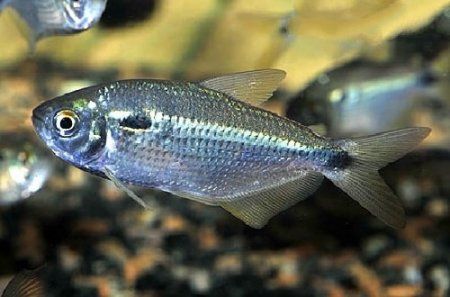
Do you want to spawn and raise a few characins? There’s a simple recipe. First buy a trio of Astyanax bimaculatus. Then set up five or six fifty gallon tanks. But wait a minute – we’re a little ahead of ourselves. What the heck is an Astyanax anyway?
The genus Astyanax consists of a large number of species of new world characins. They are to be found almost everywhere in tropical and subtropical America and even into the USA. Most species reach a length of 2 to 4 inches, some about 6 and one (A. maximus), 8″. Generally speaking, Astyanax species are rarely seen in the hobby. The reason is very simple; for the most part they are very plain fish which sell poorly and so are simply not often imported. From time to time one will see A. bimaculatus or A. fasciatus (mexicanus), but that is about all. The one major exception of course is the blind cave characin which is sometimes called Anoptichthys jordani but which is actually an eyeless, unpigmented form of Astyanax fasciatus mexicanus. Because of its unusual characteristics this fish is almost always available to the hobby.
The star of this article, Astyanax bimaculatus, has two things to recommend it. It won’t usually seriously hurt anything it can’t swallow and when fully grown (about 6″), it makes great Musky bait (just kidding – we wouldn’t want to put non-native fish into local waters even if they wouldn’t survive a winter!). Otherwise the fish doesn’t give you much to get excited about. As the name implies, there are two black spots – one on the “shoulder” and one at the caudal peduncle. You can also see some tinges of washed out red in the fins but other than this the fish is six inches of silver grey. But when a friend (?) gives you a half dozen of them and fishing season is six months away, what else can you do but try to spawn them? Breeding programs kind of get to you after a while.
After due consideration I decided that my usual five and ten gallon tetra spawning tanks wouldn’t do. Fortunately I had an empty 50 gallon tank which I filled with tap water and to which was added a large clump of Java moss. A female, recognised by her egg swollen abdomen, and a male were netted from their tank and unceremoniously dumped into this meticulously set up spawning tank. The male almost immediately darkened up and began to chase the female. An hour later it was all over – nothing had happened but it was all over nevertheless. For the next 3 or 4 days the two fish swam around, ignoring one another.
Balking at the idea that I might have to soften 50 gallons of water to kindle their interest, I decided to first try adding another male. Almost as soon as this was done, both males started chasing the female and were still at it an hour or so later when I went to bed. Kinky fish!
Some mornings are good and some aren’t. That morning when I checked the tank I wasn’t quite sure which kind it was. The two males were swimming lazily around the tank with (I swear), stupid smiles on their faces. The female was under the Java Moss and looked dead. It turned out she wasn’t but at that point she may have wished she was. Almost the entire bottom of the fifty gallon tank was covered with eggs! One would think that a 6″ long fish would have the decency to produce large eggs. Not these suckers. A female A. bimaculatus holds between 5 and 10 thousand eggs and apparently, when she spawns she spawns them all! To make matters worse, the eggs hatch in about 18 hours and the fry are free swimming in about 36. Not even enough time for fungus to kill a few of them.
After 3 or 4 days the tank began to look like it contained a good hatch of brine shrimp – wall to wall fish in dense swarms everywhere you looked in the tank. I added a lot of aeration in a hurry and began to calculate how soon the brine shrimp bill would force me into bankruptcy.
After a week, very few of these turkeys had died and, worse yet, they were growing. I knew that to raise them all I would have to split them up into the 5 or 6 fifty gallon tanks I mentioned earlier. Not being entirely crazy, I left them where they were and let nature take its course. I even added a couple of fish that I wanted to fatten up.
Nature soon did begin to sort things out. Before long a number of the fry were noticeably larger than their brethren. As time passed the larger ones became even larger and the number of fish in the tank became smaller and smaller. By the time everything was sorted out (about 5 weeks), there were about three hundred fish left, the largest of which were nearly 2″ in length. But by now the smallest fry were too large to be eaten and the population stabilised.
It was an interesting experience!
Leave a Reply